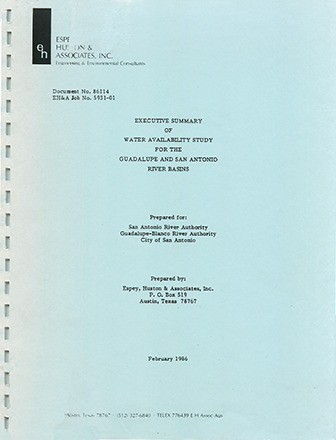Executive Summary of Water Availability Study for the Guadalupe and San Antonio River Basins

| Author | Espey, Huston & Associates, Inc, San Antonio River Authority, Guadalupe-Blanco River Authority and City of San Antonio |
| Year | 1986 |
| Description | Note: This paper is included for its historical value but has been replaced by more recent studies. Summary of studies on proposed reservoirs on the Guadalupe and San Antonio Rivers. |
| Publisher | Espey, Huston & Associates, Inc |
| Location | Guadalupe River Basin, San Antonio River Basin |
| Cover | View Download |
| File | View Download |
| Summary |
|
Note: This report is included because of its historical value. It has been replaced by more recent plans. Environmental analyses indicate no “fatal flaws” nor significant permitting problems at any of the potential reservoir sites studied. Mitigation of impacts will be required at any of the sites, which can be provided at least, in part, by peripheral land usage around the proposed reservoirs. No threatened-or endangered vegetative, wildlife, or aquatic species are known to occur in any of the potential reservoir sites. HYDROLOGY Return flows by municipalities can play a dramatic role in the yield of any of the proposed reservoirs. The Goliad Reservoir benefits directly by having a dramatic increase in firm yield on virtually a one to one ratio for each gallon of water returned to the river by San Antonio. Less dramatic but equally important, return flows from San Antonio impact the ability of water-right holders below the confluence of the San Antonio and Guadalupe rivers to obtain their water rights. Return flows also impact the ability to meet the demands of the bays and estuaries, which have been defined in these studies. Future policy decisions by the City of San Antonio regarding these return flows will have a dramatic impact on decision-making regarding reservoir development. Reductions in springflows from the Comal and San Marcos springs would have a severe impact on the ability of existing water-right holders to obtain flows which they have historically used, and would also have a severe impact upon the flows into the bays and estuaries. Likewise, the yields of Canyon Reservoir and any proposed reservoir projects would be significantly reduced by this reduction in flow, should springflows continue to diminish. Future policy decisions by the City of San Antonio and others regarding withdrawals from the Edwards Aquifer will therefore significantly impact the development of future reservoir projects. Freshwater inflow requirements to the bays and estuaries required to maintain viable biological habitat have, for the first time, been applied to reservoir firm-yield calculations. Bay and estuary flow requirements to maintain a viable habitat can be met, and will be exceeded in most years due to uncontrolled drainage areas and flood spills. Even providing for these bay and estuary requirements, significant yields can be developed from any of the potential reservoir sites…. |
Search for Documents
Advance Search
Explore EAA's Scientific Reports
- All Reports
- Surface Water / Groundwater Relationship
- Biology
- Springs, Groundwater Discharge
- Archaeology
- RZ Protection
- Aquifer Levels
- Remote Sensing
- Precipitation
- Overview Studies
- Modeling
- Hydrology and Hydrogeology
- History
- Groundwater Recharge, Recharge Zone
- Groundwater Movement
- Geomorphology and Caves
- Weather Modification
- Geology
- Water Use and Conservation
- Geochemistry
- Water Resources Planning and Management
- Floods and Drought
- Water Quality
- Climatology
